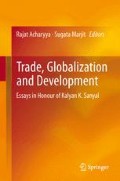Abstract
This paper analyzes the two stage quality model with un-served consumers. It is well known that the model is difficult to solve. One of the main consequences of this is that comparative static exercises are rarely carried out in the model. We show that by taking quality in the relative sense not only can the model be fully solved; comparative static exercises can be performed as well through simulation. We use the comparative static results to show that in a North – South framework, catching up by the South results in enhanced welfare for the South as well as aggregate world welfare even though the welfare for the North falls.
“China (is going) from imitation to innovation”—China daily, 24 April 2010.
Access this chapter
Tax calculation will be finalised at checkout
Purchases are for personal use only
Notes
- 1.
For a different model specification (see footnote 3) an exercise similar to what we have done here has been done by Acharyya and Bandyopadhyay (2004).
- 2.
Note this is not the only utility function that has been used to model quality. For instance Mussa and Rosen (1978) uses an utility function defined over the ith consumer where γ is discrete and is interpreted as the marginal utility of quality for the ith consumer rather than his income.
- 3.
Motta (1993) and others have considered positive costs however they have not attempted to evaluate the effects of innovation in their exercises.
References
Acharyya, R. (1998). Monopoly and product quality: separating or pooling menu? Economics Letters, 61, 187–194.
Acharyya, R. (2005). Quality discrimination among income constrained consumers. Economics Letters, 86(2), 245–251.
Acharyya, R., & Bandyopadhyay, S. (2004). Process and product innovation: complementarity in a vertically differentiated monopoly with discrete consumer types. Japanese Economic Review, 55(2), 175–200.
Choi, J. C., & Shin, H. S. (1992). A comment on a model of vertical product differentiation. The Journal of Industrial Economics, 60, 229–231.
Das, S. P., & Donnenfeld, S. (1989). Oligopolistic competition and international trade: quantitity and quality restrictions. Journal of International Economics, 58(3), 507–524.
Falvey, R.E., & Kierzkowski, H. (1987). Product quality intra industry trade and (im)perfect competition. In H. Kierzkowski (Ed.), Protection and competition in international trade (pp. 143–164). Oxford: Basil Blackwell.
Flam, H., & Helpman, E. (1987). Vertical product differentiation and North–South trade. American Economic Review, December, 810–822.
Gabszewicz, J. J., & Thisse, J. F. (1979). Price competition. Quality and income disparities. Journal of Economic Theory, 20, 340–359.
Hollander, A. (2006). First-degree discrimination by a duopoly: Pricing and quality choice. Working Paper, Département de sciences économiques, University of Montreal.
Moorthy, K. S. (1988). Product and price competition in a duopoly model. Marketing Science, 7, 141–168.
Motta, M. (1993). Endogenous quality choice: price vs quantity competition. The journal of Indutrial Economics, XLI, 113–131.
Mussa, S., & Rosen, S. (1978). Monopoly and product quality. Journal of Economic Theory, 18, 301–317.
Pula, G., & Santabarbara, D. (2011). Is China climbing up the quality ladder? Working paper no. 1310, European Central Bank.
Shaked, A., & Sutton, J. (1982). Relaxing price competition through product differentiation. Review of Economic Studies, XLIX, 3–19.
Tirole, J. (1987). The Theory of Industrial Organization. Cambridge: The MIT Press.
Wauthy, X. (1996). Quality choice in models of vertical differentiation. Journal of Industrial Economics, 44(3), 345–353.
Author information
Authors and Affiliations
Corresponding author
Editor information
Editors and Affiliations
Rights and permissions
Copyright information
© 2014 Springer India
About this chapter
Cite this chapter
Bhattacharyya, R., Mukherjee, M. (2014). Catching Up in Terms of Product Quality. In: Acharyya, R., Marjit, S. (eds) Trade, Globalization and Development. Springer, India. https://doi.org/10.1007/978-81-322-1151-8_9
Download citation
DOI: https://doi.org/10.1007/978-81-322-1151-8_9
Published:
Publisher Name: Springer, India
Print ISBN: 978-81-322-1150-1
Online ISBN: 978-81-322-1151-8
eBook Packages: Business and EconomicsEconomics and Finance (R0)

